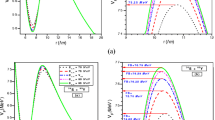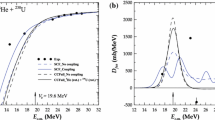Abstract
Heavy-ion collision simulations in various classical models are discussed. Heavy-ion reactions with spherical and deformed nuclei are simulated in a classical rigid-body dynamics (CRBD) model which takes into account the reorientation of the deformed projectile. It is found that the barrier parameters not only on the initial orientations of the deformed nucleus, but also on the collision energy and the moment of inertia of the deformed nucleus. Maximum reorientation effect occurs at near- and below-barrier energies for light deformed nuclei. Calculated fusion cross-sections for 24Mg + 208Pb reaction are compared with a static-barrier-penetration model (SBPM) calculation to see the effect of reorientation. Heavy-ion reactions are also simulated in a 3-stage classical molecular dynamics (3S-CMD) model in which the rigid-body constraints are relaxed when the two nuclei are close to the barrier thus, taking into account all the rotational and vibrational degrees of freedom in the same calculation. This model is extended to simulate heavy-ion reactions such as6Li + 209Bi involving the weakly-bound projectile considered as a weakly-bound cluster of deuteron and 4He nuclei, thus, simulating a 3-body system in 3S-CMD model. All the essential features of breakup reactions, such as complete fusion, incomplete fusion, no-capture breakup and scattering are demonstrated.











Similar content being viewed by others
References
M Dasgupta et al, Annu. Rev. Nucl. Part. Sci. 48, 401 (1998) and references therein
V Yu Denisov and N A Pilipenko, Phys. Rev. C 76, 014602 (2007)
J R Birkelund et al, Phys. Rep. 56, 107 (1979)
K Hagino, N Rowley and A T Kruppa, Comput. Phys. Commun. 123, 143 (1999)
A B Balantekin and N Takigawa, Rev. Mod. Phys. 70, 77 (1998)
N Chauhan and S S Godre, Proc. Symp. Nucl. Phys. 56, 640 (2011)
C Simenel, Ph Chomaz and G de France, Phys. Rev. Lett. 93, 102701 (2004)
C Simenel et al, arXiv:nucl-th/0605018v1 (2006)
A S Umar and V E Oberacker, Phys. Rev. C 74, 024606 (2006)
P Bonche et al, Nucl. Phys. A 443, 39 (1985)
K Washiyama and D Lacroix, Phys. Rev. C 78, 024610 (2008)
V E Oberacker et al, Phys. Rev. C 82, 034603 (2010)
A R Bodmer and C N Panos, Phys. Rev. C 15, 1342 (1977)
J J Molitoris et al, Phys. Rev. Lett. 53, 899 (1984)
S M Kiselev, Phys. Lett. B 154, 247 (1985)
Y Kitazoe, K Yamamoto and M Sano, Lett. Nuovo Cimento 32, 337 (1981)
A Vicentini, G Jacucci and V R Pandharipande, Phys. Rev. C 31, 1783 (1985)
V S Rammurthy and S K Kataria, Pramana – J. Phys 11, 457 (1978)
A N Dixit, V S Ramamuthy and Y R Waghmare, Pramana – J Phys. 20, 523 (1983)
S S Godre and P R Desai, Nucl. Phys. A 834, 195 (2010)
P R Desai, Effect of Coulomb reorientation on fusion cross-sections and barrier distributions of some heavy-ion reactions, Ph.D. Thesis (Veer Narmad South Gujarat University, 2009)
P R Desai and S S Godre, Proc. Int. Symp. Nucl. Phys. 54, 294 (2009)
H Holm and W Greiner, Phys. Rev. Lett. 26, 1647 (1971)
H D Marta, L F Canto and R Donangelo, Phys. Rev. C 78, 034612 (2008)
A Diaz-Torres et al, Phys. Rev. Lett. 98, 152701 (2007)
S S Godre and Y R Waghmare, Phys. Rev. C, 36, 1632 (1987)
S S Godre, Nucl. Phys. A 734, E17 (2004)
P R Desai and S S Godre, Eur. Phys. J. A 47, 146 (2011)
Y R Waghmare, Phys. Rev. B 136, 1261 (1964)
W D Myers and W J Swiatecki, Ann. Phys. (N.Y.) 55, 395 (1969)
S S Godre, Proc. Symp. Nucl. Phys. B 32, 10 (1989)
I B Desai and S S Godre, Proc. Int. Symp. Nucl. Phys. 54, 196 (2009)
S S Godre and P R Desai, Proc. Symp. Nucl. Phys. 53, 341 (2008)
C Y Wong, Phys. Rev. Lett. 31 766 (1973)
S S Godre, Proc. Symp. Nucl. Phys. B 35, 268 (1992)
S S Godre, Proc. Symp. Nucl. Phys. B 39, 192 (1996)
A J Maciejewski, Celest. Mech. Dyn. Astron. 63, 1 (1995)
S S Godre and P R Desai, Nucl. Phys. A 834, 195c (2010)
M R Morker and S S Godre, Proc. Symp. Nucl. Phys. 57, 560 (2012)
K Hagino et al, Phys. Rev. C 61, 037602 (2000)
M R Morker and S S Godre, Proc. Symp. Nucl. Phys. 56, 644 (2011)
Acknowledgement
A part of the work reported here was carried out with the financial assistance under a DAE–BRNS Project No. 2009/37/20/BRNS. The author thanks M R Morker for help with computing for some of the results.
Author information
Authors and Affiliations
Corresponding author
Rights and permissions
About this article
Cite this article
GODRE, S.S. Classical simulations of heavy-ion fusion reactions and weakly-bound projectile breakup reactions. Pramana - J Phys 82, 879–891 (2014). https://doi.org/10.1007/s12043-014-0741-6
Published:
Issue Date:
DOI: https://doi.org/10.1007/s12043-014-0741-6
Keywords
- Heavy-ion reactions
- classical microscopic approaches
- reorientation effect
- sub-barrier fusion
- breakup reactions.




